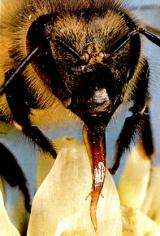March 28, 2010 weblog
New Bee Sniffing Technology Can Detect Many Dangerous Vapors At Once

(PhysOrg.com) -- While bees are extremely important to our ecology, they are becoming important to our defense against biological and other weapons, as the bee’s discreet sense of smell, equivalent to a dog’s, is being exploited as a much cheaper way to detect various odors in the environment.
As far back as 1999, the Defense Advanced Research Projects Agency (DARPA) Controlled Biological Systems Program funded a bee-training program to detect buried landmines, so that many thousands of acres of the world’s land could be productively farmed without encountering landmines the ugly way.
A bee’s natural instinct is to extend its proboscis when it encounters a desirable odor, anticipating the taste of a flower, let’s say. But the bees used in the 1999 DARPA experiment were trained, via classical Pavlovian conditioning, to respond to the odor of TNT instead. Their reward when they responded with a Proboscis Extension Reflex (PER), was a taste of sweet syrup. Then, trainers attached small diodes onto the backs of TNT-trained bees and used handheld radar tracking devices to chart where the bees went.
In 2010, bee training in the fields of defense and security, medicine, food, and building industries is big business. Bee training is essentially the same as it was in 1999, but the results are attained with more sophisticated and less expensive technology.
Inscentinal Ltd. has been working on developing very unique sensing instruments that couple the biological performance of honeybees with the technology to translate bee response into an electronic response. Inscentanil’s first proprietary design is a hand held device called the VASOR136, a trace vapor detection unit that is very versatile.

The VASOR136 contains 36 cartridges each containing one bee. Filtered in by a standard gas mask cartridge is a constant supply of clean air. When an operator presses a button on the VASOR, an air sample is taken from the environment that exposes the bees to ambient, unfiltered air. If the bees have been trained to respond to a vapor in that air, the bees will exhibit a PER response and the response will be translated by the VASOR into a simple result shown on the PDA screen display.
This BBC News video provides a glimpse at the VASOR136. The short video that is next on the BBC video page shows how bees were trained to detect TNT in Croatia in 2007.
Very neat. But the VASOR also allows for a modular approach insofar as each cartridge can contain a bee that’s been trained to identify a different vapor, giving the VASOR the ability to trace up to 36 different vapors. For security at airports the VASOR’s cost efficiency could not possibly be matched by 36 trained dogs, and other security technologies do not currently have that range of potential threats covered.
Of course, there is also the ability of the VASOR to identify diseases and cancers in people and animals, to detect rapidly spreading bacteria in food, and to identify dry rot in buildings.... The applications for the VASOR136 are just beginning to unfold.
As for the bees... after a few hours of training and two or three days on the job, they can go back to working for the Queen.
More information: Inscentinel, Sandia via New Scientist
© 2010 PhysOrg.com















